 World Running Down by Al Hess
World Running Down by Al Hess Format: eARC
Source: supplied by publisher via NetGalley
Formats available: paperback, ebook
Genres: dystopian, post apocalyptic, science fiction
Pages: 299
Published by Angry Robot on February 14, 2023
Purchasing Info: Author's Website, Publisher's Website, Amazon, Barnes & Noble, Kobo, Bookshop.org, Better World Books
Goodreads
A transgender salvager on the outskirts of a dystopian Utah gets the chance to earn the ultimate score and maybe even a dash of romance. But there's no such thing as a free lunch...
Valentine Weis is a salvager in the future wastelands of Utah. Wrestling with body dysphoria, he dreams of earning enough money to afford citizenship in Salt Lake City - a utopia where the testosterone and surgery he needs to transition is free, the food is plentiful, and folk are much less likely to be shot full of arrows by salt pirates. But earning that kind of money is a pipe dream, until he meets the exceptionally handsome Osric.
Once a powerful AI in Salt Lake City, Osric has been forced into an android body against his will and sent into the wasteland to offer Valentine a job on behalf of his new employer - an escort service seeking to retrieve their stolen androids. The reward is a visa into the city, and a chance at the life Valentine's always dreamed of. But as they attempt to recover the "merchandise", they encounter a problem: the android ladies are becoming self-aware, and have no interest in returning to their old lives.
The prize is tempting, but carrying out the job would go against everything Valentine stands for, and would threaten the fragile found family that's kept him alive so far. He'll need to decide whether to risk his own dream in order to give the AI a chance to live theirs.
My Review:
World Running Down turned out to be my third climate-apocalypse dystopia in a row, after Junkyard War and Perilous Times. The world is going to hell in a handcart and it’s all humanity’s fault no matter how you look at it. But these three looks at the view from that handcart are quite different. And all, surprisingly, hopeful.
At first, Valentine Weis doesn’t seem to have much hope. Or, perhaps, hope’s all he’s got without any real way of making any of his hopes come close to realization. At least not until Osric drops into his life – just about literally – with an offer that Valentine probably should refuse.
Because anything that looks too good to be true generally is – especially with people who actually still have a conscience and at least an ounce of compassion for their fellow beings. However those beings present themselves and whatever they happen to be made of.
In his very post-climate apocalypse world, Valentine lives his life on the outside looking in. Someone is offering him the opportunity to finally be on the inside. The question is whether the price is one that he’s willing to pay.
Salt Lake City is one of the few remaining, functional cities in the U.S. It’s a place where healthcare and transportation are free, where it seems as if everyone has enough to eat and a place to live. It’s a place where the rich get richer and the poor peek through the glass at all the things they can’t have without citizenship. Or sponsorship. Or both.
Valentine has none of the above. Instead his only possession is a barely functioning van, his only friend is more of a frenemy, he’s just barely breaking even on the delivery and salvage jobs he takes to keep body and soul together. And he’s trapped in a body he knows is wrong, deals with regular and depressing bouts of body dysmorphia and keeps falling further behind in his quest to save up enough money to get admitted to the place where he can get the medicines and the surgery he needs to make his external appearance reflect his inner self.
Osric, on the other hand, isn’t even human. He’s a Steward, an elite artificial intelligence who has been placed in a mere android body by nefarious person or persons unknown and sent out by even more nefarious persons to rope Valentine and his friend Ace into a job that must have one hell of a catch – because the fee for doing it is beyond Valentine’s biggest hopes and best dreams.
Which he just might manage to make come true. Not by giving in to what either those nefarious persons or his best frenemy/business partner Ace might say is the best thing – but by doing the actual, honest-to-goodness right thing. No matter how much it breaks his heart.
Escape Rating A: Before I even attempt to get into any more detail, first things first. And the first thing is that I loved World Running Down. A lot. Which kind of surprised me, not for itself, but because it was the third climate apocalypse dystopia book I read in a row, and as a subject that’s kind of a downer.
But the book itself isn’t a downer at all, which is really all down to Valentine. He just so earnestly wants to be a genuinely good person in spite of the world running down. Given a choice between the right thing and the easy thing Valentine chooses the right thing every single time – quite often to his own detriment.
He’s not unrealistic – at all – about just how FUBAR’d his world has become. He just doesn’t let that affect his own decision making process. He knows that things overall are heading towards an even hotter place than the climate, and he’s cognizant that he can’t fix much of that. But he’s committed to making things a little better as he can to those whose lives he actually touches.
Which is what gives the story both its hopefulness and its poignancy.
Valentine himself is caught in a “catch-22”. He’s trans, he needs both meds and surgery to complete his transition – which he very much desires to do. To be able to do that he needs to get residence in Salt Lake City, and for that he needs to pass a citizenship test. Which is just as big a hurdle because Valentine has ADHD or some variant of it which hasn’t even been diagnosed, making it difficult for him to study and retain certain kinds of information. Math gives a lot of people trouble. It gives Valentine a double dose of trouble, and he needs to get it to pass the test. Doing the original job would be a shortcut to his dreams – but absolutely does come at much too high a price.
But this isn’t just Valentine’s story, although we see much of it from his perspective. It’s also Osric’s story, and it’s the story of the job they are contracted for and the huge cloud wrapped around the silver lining of the payoff for doing it. Both parts of which result in discussion of artificial intelligences and the definition of what makes a being of artificial intelligence intelligent enough to be self-aware and eligible for citizenship.
And then the whole story works its way around to just how much heartache and heartbreak can be caused by trying to do what you think is best for someone you care for and how demeaning it is to make those decisions without their input.
There’s more. There’s just so much more. More than I should get into here, no matter how tempted I am. Which is very.
Between the climate apocalypse, the dystopian elements, the so, so sharp divide between the haves and the have nots, and both the political and the romantic issues that are raised by the questions of sentience and artificial intelligence, World Running Down touched on themes that brought to mind (my mind at least) a whole shelf of books that a reader might find equally appealing and/or interesting and very much vice versa.
So if you’ve ever read any of the following, you will probably also find World Running Down to be running right up your reading alley. And if you like World Running Down, these may also appeal; A Psalm for the Wild-Built by Becky Chambers, In the Lives of Puppets by TJ Klune, Automatic Reload by Ferrett Steinmetz and The Space Between Worlds by Micaiah Johnson.
I wish you hours of joyful reading in some fascinating worlds gone very wrong that still have hope of things coming round right. Definitely starting with World Running Down. But don’t just take my word for it. World Running Down is in the midst of running on tour at the following sites. Check ’em out!

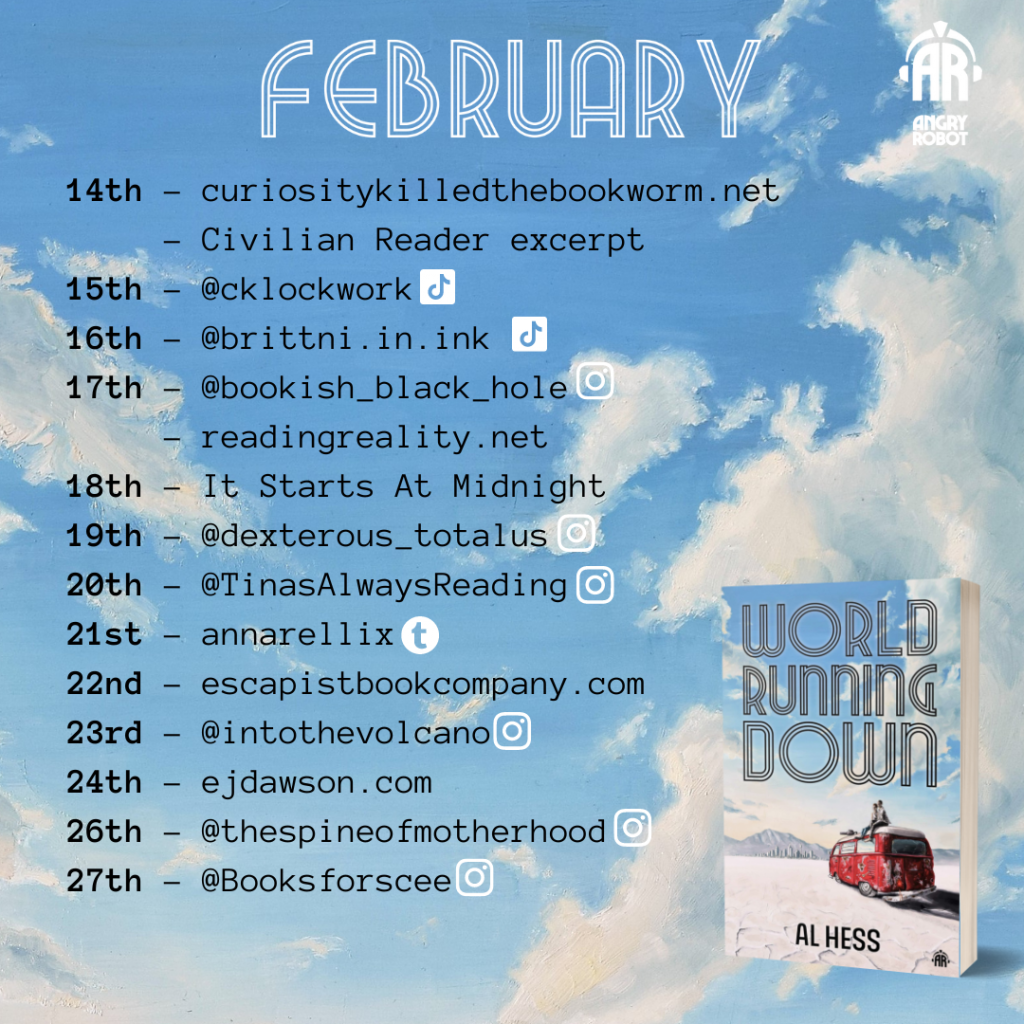 FEBRUARY
FEBRUARY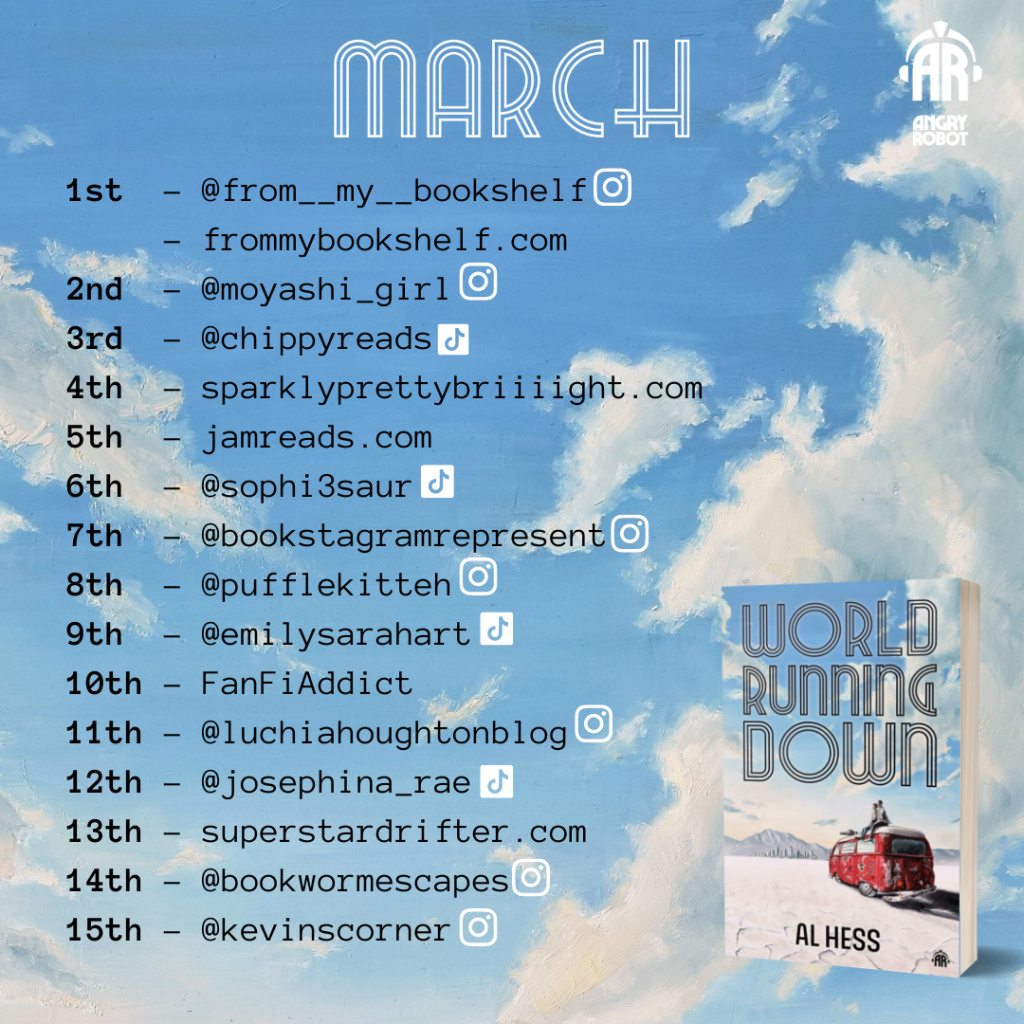 MARCH
MARCH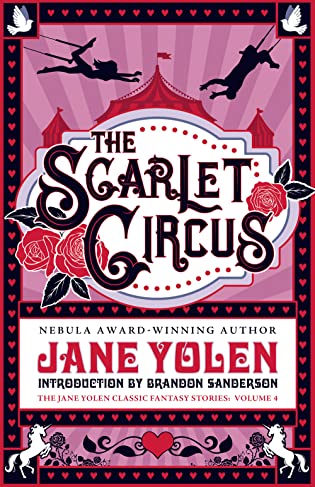 The Scarlet Circus by
The Scarlet Circus by 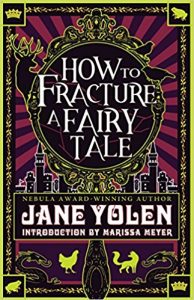 This ended up being my Valentine’s Day review because, to paraphrase the author’s forward just a bit, while the stories contained within are not “Romances” with a capital R, each story does contain a romantic element – even if that element is not the center of the story and seldom results in anything like a happy ever after.
This ended up being my Valentine’s Day review because, to paraphrase the author’s forward just a bit, while the stories contained within are not “Romances” with a capital R, each story does contain a romantic element – even if that element is not the center of the story and seldom results in anything like a happy ever after.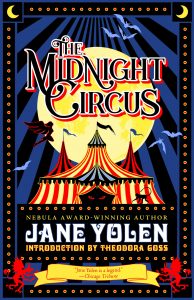 Those initial stories were interesting and fun but didn’t quite touch my heart – although “Dusty Loves” certainly tickled my funny bone a bit. These next ones, however, got a bit closer to the heart of the matter – or at least my heart.
Those initial stories were interesting and fun but didn’t quite touch my heart – although “Dusty Loves” certainly tickled my funny bone a bit. These next ones, however, got a bit closer to the heart of the matter – or at least my heart.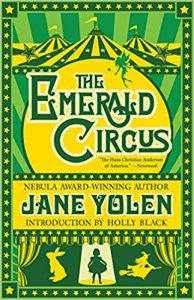 Escape Rating A-: Like most collections, the stories are a bit all over the map. I adored a couple, liked quite a few more, and a small number just missed the mark for me in one way or another – as the above descriptions show. But overall I’m very glad I picked this up, and enjoyed the ways that it played with romances of many types and stripes and definitions. That “love is all there is is all we know of love” doesn’t have to mean that all loves are exactly the same type.
Escape Rating A-: Like most collections, the stories are a bit all over the map. I adored a couple, liked quite a few more, and a small number just missed the mark for me in one way or another – as the above descriptions show. But overall I’m very glad I picked this up, and enjoyed the ways that it played with romances of many types and stripes and definitions. That “love is all there is is all we know of love” doesn’t have to mean that all loves are exactly the same type.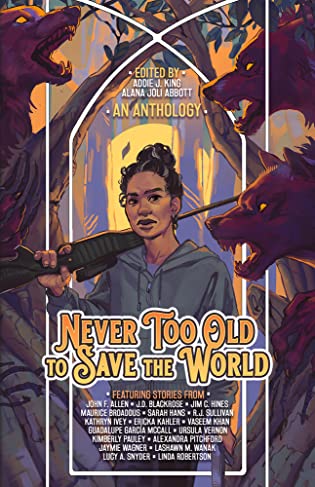 Never Too Old to Save the World: A Midlife Calling Anthology by
Never Too Old to Save the World: A Midlife Calling Anthology by 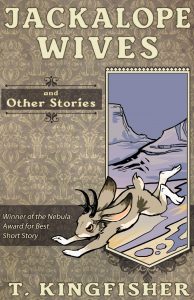 My favorite fantasy story is “Jackalope Wives” by Ursula Vernon – who also writes marvelously fantastic fantasy and horror as T. Kingfisher. “Jackalope Wives” is the only story in the book that has been previously published, originally in
My favorite fantasy story is “Jackalope Wives” by Ursula Vernon – who also writes marvelously fantastic fantasy and horror as T. Kingfisher. “Jackalope Wives” is the only story in the book that has been previously published, originally in 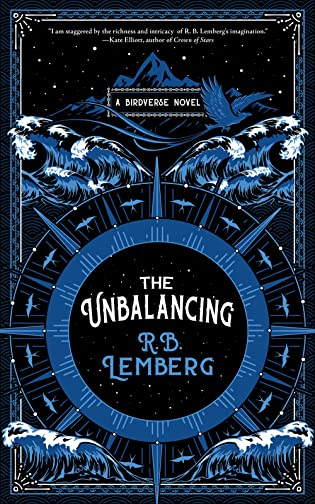 The Unbalancing by
The Unbalancing by 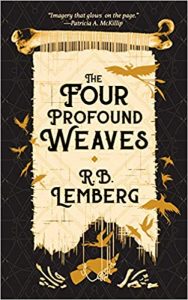 Escape Rating A: I enjoyed my introduction to the
Escape Rating A: I enjoyed my introduction to the 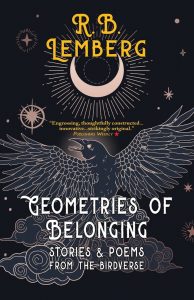 What gives this story its oomph – and lots of it – is the race to heal the star and save the islands. That the effort fails seems like it would be one hell of a downer – but it’s not. What makes the story rise in the end is the acknowledgement that the land, though beautiful, is not important. It’s the people that made the islands, and they’ll find a new place that they will make just as beautiful and fruitful, because they are bringing both the heart of Gelle-Gau and the heart of their beleaguered star along with them.
What gives this story its oomph – and lots of it – is the race to heal the star and save the islands. That the effort fails seems like it would be one hell of a downer – but it’s not. What makes the story rise in the end is the acknowledgement that the land, though beautiful, is not important. It’s the people that made the islands, and they’ll find a new place that they will make just as beautiful and fruitful, because they are bringing both the heart of Gelle-Gau and the heart of their beleaguered star along with them.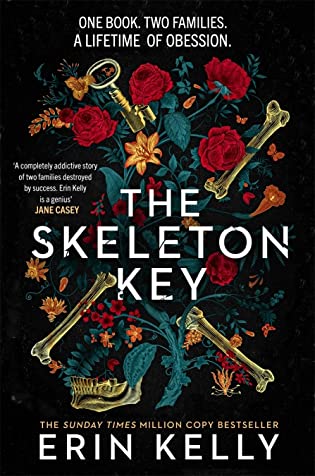 The Skeleton Key by
The Skeleton Key by 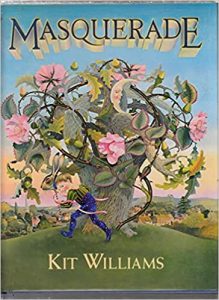 Two things to start. First, the concept of The Golden Bones may sound vaguely familiar – and that’s intentional on the part of the author and acknowledged at the beginning. There was a real, worldwide craze for armchair treasure hunt books in the 1980s, kicked off by the publication of the massively illustrated puzzle/story book
Two things to start. First, the concept of The Golden Bones may sound vaguely familiar – and that’s intentional on the part of the author and acknowledged at the beginning. There was a real, worldwide craze for armchair treasure hunt books in the 1980s, kicked off by the publication of the massively illustrated puzzle/story book  The Cat Who Saved Books by
The Cat Who Saved Books by 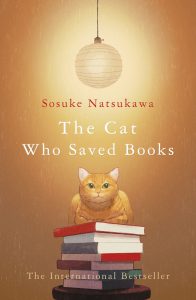 Escape Rating A-: I picked this one up for the cat and the books, in that order. Which reminds me that the cat pictured on the US cover does not do Tiger the Tabby justice. The UK cover (pictured at left) does a much better job of giving Tiger his due.
Escape Rating A-: I picked this one up for the cat and the books, in that order. Which reminds me that the cat pictured on the US cover does not do Tiger the Tabby justice. The UK cover (pictured at left) does a much better job of giving Tiger his due.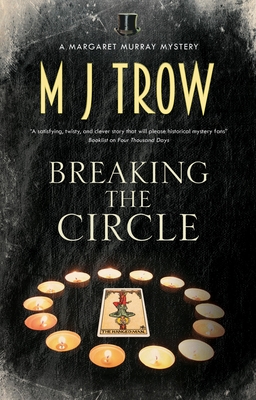 Breaking the Circle (Margaret Murray, #2) by
Breaking the Circle (Margaret Murray, #2) by 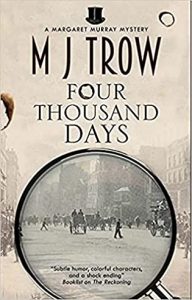 Escape Rating A-: What makes this series work, at least for this reader, is the voice of its protagonist Dr. Margaret Murray. Not just because she was a real person – as were both Flinders Petrie and Edmund Reid, but because she led the kind of life, had the type of career, and left behind the writing to make the adventures that her fictional avatar gets herself into seem not just plausible but even possible.
Escape Rating A-: What makes this series work, at least for this reader, is the voice of its protagonist Dr. Margaret Murray. Not just because she was a real person – as were both Flinders Petrie and Edmund Reid, but because she led the kind of life, had the type of career, and left behind the writing to make the adventures that her fictional avatar gets herself into seem not just plausible but even possible.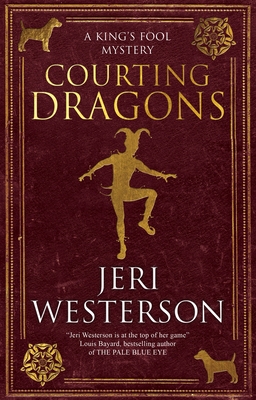 Courting Dragons (A King's Fool mystery, 1) by
Courting Dragons (A King's Fool mystery, 1) by 
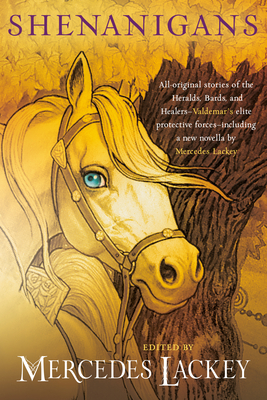 Shenanigans (Tales of Valdemar, #16) by
Shenanigans (Tales of Valdemar, #16) by  Last week’s
Last week’s 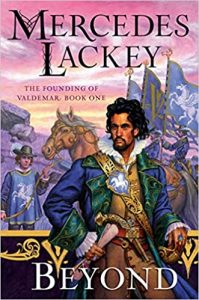 Of course, there are also several stories set among the students of the Collegium, because, well, students and pranking make for a fun story no matter what world they’re set in.
Of course, there are also several stories set among the students of the Collegium, because, well, students and pranking make for a fun story no matter what world they’re set in.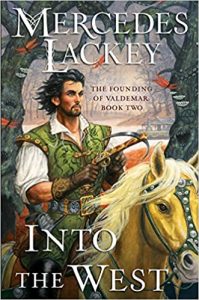 Last but not least there’s, Diana Paxson’s “One Trick Pony”, which mixes a bit of the bittersweet memory of heartbreak and the horrors of war into its story about a man who has found peace after grief and war by gardening, and the way that peace is invaded by a woman who reopens his heart and a newly born Companion who is learning the limits of their own power one prank at a time.
Last but not least there’s, Diana Paxson’s “One Trick Pony”, which mixes a bit of the bittersweet memory of heartbreak and the horrors of war into its story about a man who has found peace after grief and war by gardening, and the way that peace is invaded by a woman who reopens his heart and a newly born Companion who is learning the limits of their own power one prank at a time.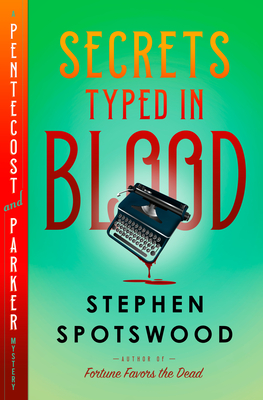 Secrets Typed in Blood: A Pentecost and Parker Mystery by
Secrets Typed in Blood: A Pentecost and Parker Mystery by 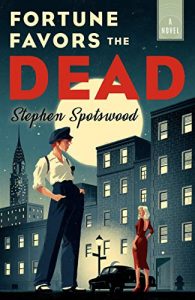 The first book in the Pentecost and Parker series, the utterly marvelous
The first book in the Pentecost and Parker series, the utterly marvelous 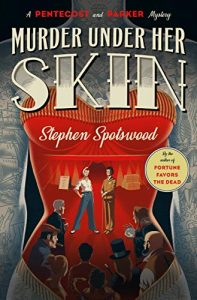 Escape Rating A-: Both of Pentecost and Parker’s previous cases,
Escape Rating A-: Both of Pentecost and Parker’s previous cases,